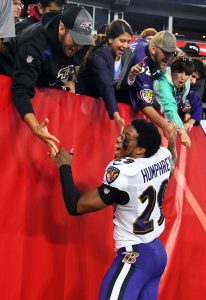What do we know about the NFL in 2019? We know that running backs don’t matter. We know that passing offense does matter. And if passing offense matters, then stopping the pass must matter, too.
Pro Football Focus recently ran a study focusing on the importance of pass coverage versus pass rush. While PFF stopped short of definitively saying that coverage is more critical than applying pressure, the data seems to lean in that direction. Here’s what PFF data scientists Eric Eager and George Chahrouri found:
During the PFF era, teams with elite coverage (67th percentile or better) and a poor pass rush (33rd percentile or worse) win, on average, about a game and a half more than teams with the reverse construction.
The team that’s invested the most cap dollars in its cornerbacks for the 2019 campaign? The Baltimore Ravens, who are spending a league-high $36.509MM on CBs for the upcoming season. Let’s take a look at their projected depth chart:
- Marlon Humphrey ($3.341MM cap figure): Baltimore’s first-round pick in 2018, Humphrey’s snap percentage increased from 55% during his rookie year to 80% last season. He ranked second in the NFL in Football Outsiders’ success rate, a measure of how often ac corner stops opponent’s “successful” plays based on down, distance, and situation.
- Brandon Carr ($7MM): Now 33 years old, Carr has remarkably never missed a game in his 11-year NFL career. Doug Farrar of USA Today’s Touchdown Wire recently ranked Carr as the NFL’s fourth-best outside corner, noting his ability to “diagnose routes as well as anyone in the business.”
- Jimmy Smith ($15.85MM): Smith has posted an up-and-down career with the Ravens, and 2018 was not his finest season in Baltimore. He was suspended for the first four games of the year after violating the NFL’s personal conduct policy, and wasn’t all that effective when he returned. Still, the Ravens kept him around despite his team-leading cap charge.
- Tavon Young ($3.651MM): Among corners who spent at least 20% of their time in the slot last year, Young ranked seventh in PFF’s coverage snaps per reception. He set the market for slot corners with an $8.6MM annual value on his February extension, a figure that new Lions CB Justin Coleman topped the following month.
- Anthony Averett ($735K): A fourth-round pick out of Alabama in 2018, Averett missed several games with injury and only played 71 defensive snaps. For now, he’ll make his mark on special teams, where he saw action on 147 snaps last year.
- Iman Marshall ($664K): Like Averett, Marshall is a fourth-rounder, albeit in the 2019 draft. He’ll work on special teams unless an injury strikes.
The Ravens have other corners such as Stanley Jean-Baptiste, Justin Bethel, and Maurice Canady who might be able to find spots on other clubs, but if Baltimore only keeps six cornerbacks, none of that group will likely be on the roster. Cyrus Jones, meanwhile, is essentially a cornerback-in-name-only, and could still make the Ravens’ roster as a return man.
Having four corners — Humphrey, Carr, Smith, and Young — who are all more than serviceable starters is something of a luxury. But the Ravens are more equipped than most teams to handle the logjam. Baltimore deployed at least four cornerbacks (dime defense) on 26% of its plays in 2018, according to Bryan Knowles of Football Outsiders. That figure ranked sixth in the NFL and was roughly double the league average dime rate.
Could the Ravens end up trading one of their corners? It seems unlikely, despite Baltimore’s long-standing inclination to acquire future assets. Humphrey isn’t going anywhere, and the same can probably be said for Carr. Smith is likely untradeable due to his contract, and Young won’t be on the move after inking an extension earlier this year.
Instead, it’ll be up to defensive coordinator Don Martindale to determine how to most effectively use his bevy of corners. The Ravens ranked third in pass defense DVOA in 2018, and while regression could certainly hit, it will be a surprise if Baltimore isn’t among the top pass defenses once again in 2019.

Trying to evaluate one area of defense against another is like trying to determine which internal part of a watch is most important. It’s basically an exercise in futility. Even if the PFF study was scientific and not based on their subjective grading system there is no conclusive evidence to support the idea that spending more leads to more success. The Ravens lead in cornerback spending having had a -3 turnover ratio last season. The Seahawks are spending the least amount on cornerbacks having led the league last season with a +15 turnover ratio. None of this comes as a surprise.